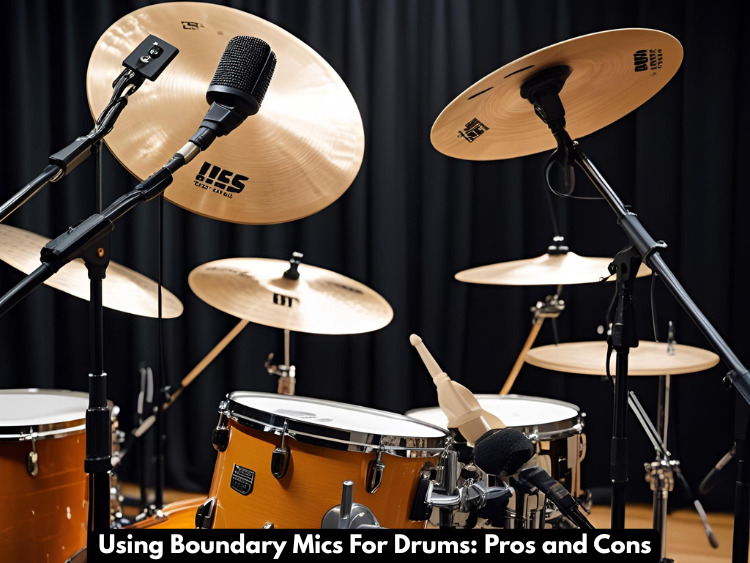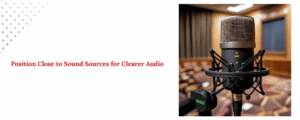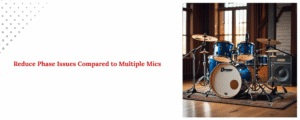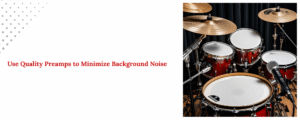Engineers and artists can record drums using various types of microphones. Most likely, you know about the common types, like dynamic and condenser mics. Boundary mics, also known as PZMs, are another type that is less commonly discussed. You can use them to record drums, but like everything else, they have their pros and cons. Check out this article for the pros and cons of using boundary mics on drums. This will help you decide if they would work well in your live or recorded sound setting.
How Do You Use Boundary Microphones?
Now, before we get to the advantages and disadvantages, let us just briefly discuss what boundary mics are. Boundary mics are unlike regular mics, inasmuch as they are designed to be used somewhere inside a flat surface, which can be a drum shell, the floor, or even against the wall. They are able to record clear and realistic sound with minimum phase problems because they record bounced sound waves on the surface.
They have a hemispherical pickup pattern and therefore they will receive the sound equally over a large surface above the surface to; they are attached. They are not focused on one drum or even one cymbal, as many drum mics are.
Why Using Boundary Mics for Drums Is a Good Idea
Using boundary microphones gives a realistic sound to your drum kit. Boundary mics are different from standard mics since they capture sound coming back from the drum shell and the nearby floor. Thanks to this, you record the main sound plus the echo, which makes the music sound richer and more exciting. They make it easier to get a clear and natural sound by eliminating phase issues you might get with many mics.
Set up goes faster—with fewer microphones and audio cables involved, you use less time and have less mess. Since they are flat and rigid, boundary mics are easier for the performers to use and more likely to survive the events unharmed. A pair of them is commonly used overhead, helping to give the drums an even, spacious and clear sound. In general, boundary microphones make it easy to get natural and hassle-free drum sounds in your mix.
Why You Shouldn’t Use Boundary Mics for Drums
- Less Isolation: Boundary mics pick up more background sounds, so it’s hard to hear just one drum clearly—like the snare or kick.
- Too Much Room Sound: They capture a lot of room echo, which can make drums sound far away or unclear. This isn’t great for loud or punchy music like rock or metal.
- Sound Changes with Surface: The sound varies according to the placement of mic. Its sound can vary depending on different floors or drum shells, hence it is difficult to achieve the same sound each time it is used.
- Less Control: You are unable to adjust each sound of drums as you could do close-up mics and mixing becomes difficult.
- Picks Up Floor Noise: If placed on the floor, the mic might catch unwanted sounds like foot tapping or stand movements.
When Should You Use Boundary Mics on Drums?
When recording a realistic, ambient sound of the drum kit, boundary mics work best. Jazz, acoustic sessions, and ambient music are all great places to use them because the drum sound is big and open.
Also, they come in handy when you need to set up quickly and with little gear, like when you’re doing live sound or in a practice area. When used with standard drum mics, boundary mics can add a new viewpoint or be used as Overhead or Room Mics.
How to Use Boundary Mics with Drums
- Try Different Placements: To get the best sound, try putting boundary mics on the bass drum shell, the floor tom, or even the floor next to the kit.
- Combine with Close Mics: Using boundary mics as overheads or room mics with close mics on the snare and kick will give the drum sound more depth and balance.
- Use Good Preamps: Since border mics can pick up more background noise, good preamps and the right way to set the strength help keep the sound clear.
- Think About Shock Plates or Isolator Pads: To cut down on mechanical noise from vibrations, try keeping the mic away from objects that are moving directly.
Last Thoughts
In the case of miking drums, there is a new alternative which is called boundary microphones, and some of its advantages are evident, such as capturing ambient sound in the room and minimizing phase issues. However, their overall sound and inability to be isolated a problems in styles or circumstances where tightness and piercings are desired on the drums.
Boundary mics are a fast method to produce an accurate drum kit sound or a layer of environment on your drum tracks, so you should consider that. Similar to any other sound device, their effectiveness in relation to you depends on your objectives in music, the environment, and how you blend.




